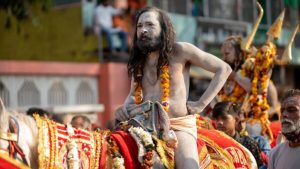 Technology
Technology  Technology
Technology  Humans
Humans 10 Everyday Human Behaviors That Are Actually Survival Instincts
 Animals
Animals 10 Animals That Humiliated and Harmed Historical Leaders
 History
History 10 Most Influential Protests in Modern History
 Creepy
Creepy 10 More Representations of Death from Myth, Legend, and Folktale
 Technology
Technology 10 Scientific Breakthroughs of 2025 That’ll Change Everything
 Our World
Our World 10 Ways Icelandic Culture Makes Other Countries Look Boring
 Misconceptions
Misconceptions 10 Common Misconceptions About the Victorian Era
 Mysteries
Mysteries 10 Strange Unexplained Mysteries of 2025
 Miscellaneous
Miscellaneous 10 of History’s Most Bell-Ringing Finishing Moves
 Technology
Technology Top 10 Everyday Tech Buzzwords That Hide a Darker Past
 Humans
Humans 10 Everyday Human Behaviors That Are Actually Survival Instincts
 Animals
Animals 10 Animals That Humiliated and Harmed Historical Leaders
Who's Behind Listverse?

Jamie Frater
Head Editor
Jamie founded Listverse due to an insatiable desire to share fascinating, obscure, and bizarre facts. He has been a guest speaker on numerous national radio and television stations and is a five time published author.
More About Us History
History 10 Most Influential Protests in Modern History
 Creepy
Creepy 10 More Representations of Death from Myth, Legend, and Folktale
 Technology
Technology 10 Scientific Breakthroughs of 2025 That’ll Change Everything
 Our World
Our World 10 Ways Icelandic Culture Makes Other Countries Look Boring
 Misconceptions
Misconceptions 10 Common Misconceptions About the Victorian Era
 Mysteries
Mysteries 10 Strange Unexplained Mysteries of 2025
 Miscellaneous
Miscellaneous 10 of History’s Most Bell-Ringing Finishing Moves
10 Deadly Types of Warrior Monks and Spiritual Soldiers
From Star Wars Jedi knights to Batman’s League of Shadows, the idea of monastic warriors has long captured people’s imaginations. They are often shown as highly skilled combatants who use secret techniques, which they spend every waking hour training to master. In real life, the efficacy of their methods is up for debate, but the dedication to their craft is very much real.
Actual monks who fought were found in the Buddhist Far East and Christian Europe. However, religiously motivated martial sects with disciplined lifestyles were found in many places. What follows are ten examples of such groups, each being one of history’s most hardcore warrior communities. Some are well-known, some are still around, and all are dangerous. Here are ten of the world’s deadliest orders of warrior monks.
Related: 10 Knights Of The Round Table You’ve Never Heard Of
10 Aztec Warrior Cults
The Aztecs had their priests, but before the Conquistadors brought Christianity to Mexico, there did not appear to be any monks. However, there were at least three temple-dwelling cults of skilled combatants dedicated to war and worship: the Jaguar Warriors, the Eagle Warriors, and the Shorn Ones.
The Jaguar Warriors worshiped the god of the night sky, Tezcatlipoca, and were named for their battle dress. This was a full jaguar pelt with the head worn over their own so that their face poked out through the jaguar’s fearsome mouth. The Eagle Warriors shared the same entry requirement as the Jaguars: capture four enemy soldiers. But they worshiped Huitzilopochtli, the god of war, and their armor included beaked masks and feathered collars. They also had access to the House of Eagles, a meeting place within the Templo Mayor complex in what is now Mexico City.
The Shorn Ones were considered to be even more elite. They wore personalized armor but shared the same haircut, which was bald except for one long braid. They were the first into battle, which was surprising given that Shorn Ones had to be from the Aztec nobility. The idea was to frighten the enemy into thinking all the Aztec warriors were as good as them.[1]
9 Berserkers
Despite their tendency to, well, go berserk, the berserkers were actually quite a spiritual bunch. They were devotees of the top Norse god, Odin, who they believed fueled their battlefield frenzies. In fact, they thought the crazed fighting state that made them such ferocious enemies came directly from Odin through “Óðr,” which is roughly the Norse equivalent of divine inspiration. It was the same source that inspired poetry and philosophical insight.
This made going berserk—entering a manic state on the battlefield while wearing only a bear or wolf pelt—essentially a sacred act. The warriors have also been called “Odin’s Men.” In common with other groups of monastic warriors, berserkers’ training was harsh. They would spend time living like animals in the wild, hunting and gathering to survive. They might also have used some special techniques, such as fasting and heat exposure, to achieve their famed state of bloodthirsty trance.[2]
8 Cossack Sorcerers
Over time, the abilities of mysterious and elite fighting forces can become overstated. That is certainly the case with the Cossack Sorcerers. Catching bullets, causing rivers to dry up, and levitation were among their many reputed powers. Exaggerated though their skills might be, the Cossacks were elite warriors, and their reputation lives on today.
They came from Ukraine, which in the 16th century was part of the Commonwealth of Rye, now Poland. “Cossack” comes from the Turkic word for “free people,” and they spent much time fighting for their freedom against the Commonwealth and the Poles.
The superb fighting skills of the Sorcerers started in childhood when elders would train them in the arts of hand-to-hand combat, sword fighting, horse riding, and shooting. They were also taught how to make herbal medicines and achieve altered states of consciousness. As for reports of their magical powers, these can probably be attributed to illusion and trickery. The Cossack Sorcerers just practiced a different form of that essential concept of effective warfare—deception.[3]
7 Knights Templar
The Knights Templar were real warrior monks. That is to say, they were a recognized religious order, but they were also dedicated to waging war in God’s name. They were so good at it that this modest group, who called themselves “The Poor Knights of the Temple of King Solomon,” became one of the richest and most powerful organizations in medieval Europe.
The knights were not allowed to share in the Order’s wealth, however. They were sworn to poverty by “The Rule of the Templars.” That was their code of conduct, which also stipulated that they could never retreat or surrender without being ordered to do so. This helped make them fierce fighters, and they were shrewd strategists, too.
In the end, the Order became too powerful and wealthy. In 1307, every Templar house in France, to where they had moved their operations, was raided by the order of the king. Many knights were tortured and burned at the stake. But more than 700 years later, the Knights Templar continues to inspire power-hungry organizations and secret societies.[4]
6 Naga Sadhu

People attending the next Kumbh Mela—the world’s largest religious festival—in India might bump into a few Naga Sadhu. These Hindu holy men are easily recognized, as they are likely to be naked, covered in ash, and sporting long, matted dreadlocks. Today, they need not be feared, but a few centuries ago, it was a different story. These ascetic devotees of Shiva were highly-trained and deadly soldiers who fought on horseback and on foot.
By the late 1700s, there were more than 20,000 Naga Sadhu warriors, and they were well-armed with sabers, cannons, and muskets. But their reputation as fearsome fighters had been built back when they were shock troops who got up close and personal, engaging their enemies in hand-to-hand combat. They did not even wear shoes, let alone armor, but their thick hair could be wrapped around their heads into a sort of helmet.
It is possible the sect survived so long because, even though they were brave soldiers, they were not obligated to stand and fight no matter what. Smart leaders like Anupgiri Gosain knew when to make a hasty exit. They also knew how to back winners and changed their allegiance often.[5]
5 Nihang
It sounds like something from a movie: A young man travels to India and becomes the only student of an elderly hermit who teaches him a secret martial art. But that is what happened to Nidar Singh from the UK, who would then save shastar vidya, the “science of weapons,” from being forgotten by teaching his own students.
The fighting style was created by 17th-century Sikhs in India to defend themselves from Muslim and Hindu attacks. It became associated with a militant sect called the Nihang, or the Akali, known for their distinctive blue turbans. As a testament to their ferocity in battle, the name Nihang comes from the Persian word for “crocodile.” Akali means “eternal one,” but these fearless warriors were originally the suicide squads of Sikh armies in the 1600s.
In the 20th century, the Nihang returned, but they were less focused on warfare. They helped end British rule in India, split the state of Punjab into one majority Sikh and one Hindu state, and now lend their name to a political party.[6]
4 Shaolin
China’s Shaolin Temple is basically synonymous with warrior monks. They have had a long time to build their reputation; the first Shaolin temple was built almost 1,500 years ago when Buddhism first arrived in China. They are famous today for their hand-to-hand combat techniques, but these emerged later in the 16th and 17th centuries. Before that, they became lethal fighters first out of the need to defend themselves from bandits, then by helping armies win wars and bring stability to China.
The Shaolin became an immense fighting force, as demonstrated when 120 monks killed over 100 pirates while only four of their own were harmed. Their original weapon was the staff they were required to carry, but they also used spears and tridents. Their famous unarmed combat techniques were mainly used by the monks for spiritual and physical development, not fighting.
However, they almost disappeared following Mao’s Cultural Revolution, but their mystique, shaved heads, and gray robes inspired many films. These helped bring tourists to the temple, making the Shaolin monks the most famous warrior monks in the world.[7]
3 Sohei
The Sohei were warrior monks from medieval Japan. Unlike China’s Shaolin, the Sohei were a large order like the Knights Templar, and they were not associated with a single temple. They appeared in the Heian period from AD 794 to 1185 when different Buddhist sects were at war. A dispute between monks from Kyoto and the monastery of Enryaku-ji led to the latter creating the first standing army of warrior monks in 970, with their own code of conduct and a long and brutal training program.
Many Sohei followed suit and began living in communities where they would perfect and teach their methods for maintaining battle readiness. By doing so, they are thought to have been the first full-time warriors ever. They became sought after by clan leaders and warlords, participating in centuries of conflicts. At the height of their power, the Sohei were even a match for the Samurai. Still, by the 17th century, they had been almost completely wiped out by Oda Nobunaga, the first great unifier of Japan.[8]
2 Beomeosa Temple Monks
Like how different orders of warrior monks sprung up across medieval Europe, many appeared across Asia, too. In Busan, South Korea, one mysterious order only recently started to open itself up to the public after centuries of secrecy. The Fighting Monks of the Beomeosa Temple made their name in the 1500s by defending Korea against Japanese invaders.
Many warrior monk groups did the same, joining Korea’s “Righteous Army” to fight the Japanese during the Imjin War. But the Beomeosa Temple might have had a harder role because it is only 30 miles ((48 kilometers) from Japan’s Tsushima Island. The monks used a variety of weapons to force their invading neighbors to retreat, including swords, spears, and throwing stars. The secret to their military prowess was apparently a secret martial art called Sunmudo.
Today, a weaponless version of Sunmudo is taught and practiced at the temple as a form of meditation, but do not be fooled into thinking they have gone soft. As part of the warrior lifestyle, would-be monks might have to rise as early as 4 am, run to the tops of mountains, and practice their strikes on trees and heavy stones.[9]
1 Teutonic Order
The Teutonic Order started out giving aid to sick people in Palestine during the Third Crusade, but it would soon become one of the most vast, mobile, and powerful organizations in Eastern Europe. Although it was founded by German merchants, it became militarized in 1198 due to a lack of German knights to defend Palestine. At this time, the Order was made of monastic knights like the Templars. But they soon began shifting their operations away from the Middle East to help European nobles by protecting their land and converting people to Christianity.
The Order was granted a lot of autonomy to do this, which they used to seize power for themselves. This saw the knights kicked out of Hungary, but over the 13th century, they managed to conquer Prussia, along with parts of the Baltic states and Poland. Like some of the other groups on this list, the Teutonic Order became so powerful that others wanted them taken out.
Poland and Lithuania took advantage of a rebellion against the Order to defeat them in battle in 1410. This set in motion their gradual dissolution over the centuries that followed. Some of the knights, such as those in Austria, held on until the 19th century. In fact, the Order still survives there today, but only after it was revived by the emperor as a religious charity in 1834.[10]








